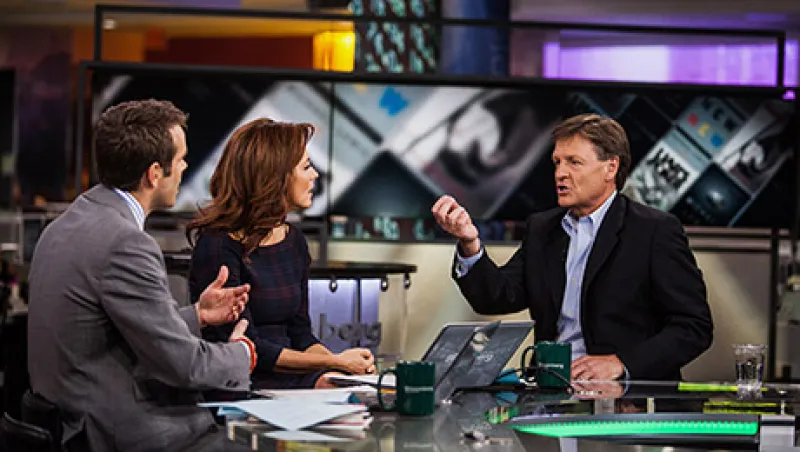Financial news TV does two things well: commentary on the equities market and shouting. Michael Lewis’s highly entertaining publicity skip through the cable networks this week has offered plenty of the latter and virtually no insight into the former. Lewis put forth a shouty premise to kick the week off — “The markets are rigged,” he boldly declared on CBS’s 60 Minutes — and was dutifully handed three days of shouting in reply. From early on Monday morning, as Lewis has toured the media to promote Flash Boys: A Wall Street Revolt , which looks at high frequency trading and the rise of new alternative trading venue IEX Group, the enraged pachyderms of financial cable TV have lined up to tell him how terribly wrong and dangerous his new book is. It has made for pointless debate and great TV.
Lewis’s week began on Sunday night in friendly, obliging, soft-focus territory: 60 Minutes launched the book with a 15-minute piece that featured much shaky, handheld walk-through footage of data centers, set to voice-overs that intoned with appropriate end-of-the-world menace, “Trades are being made by thousands of robot computers.” The “attack of the clones” theme continued through the early week — “Markets: Man Vs. Machine” was CNBC’s bottom-of-the-screen summation of the debate on Tuesday. High frequency traders, exchanges and interest groups like the Modern Markets Initiative quickly mobilized in response, taking to Twitter and other media to shoot down the book’s central claims. Meanwhile, Lewis was swept from the giddy comic triumphalism of The Daily Show to the icy, Left Bank darkness of an interview with Charlie Rose to the set of Bloomberg TV. By the end of Wednesday, as Lewis lumbered onto HuffPost Live, shirt unbuttoned to midchest and hair pushed off at angles rarely glimpsed on a TV screen, he had the bedraggled air of a failed circus clown on his 15th whisky and ready to give up.
The highlight of the week was the appearance of William O’Brien, president of BATS Global, on CNBC on Tuesday alongside Lewis and Brad Katsuyama, chief executive of IEX, for an exchange that peaked with O’Brien repeatedly shouting at Lewis: “You never visited BATS! You never came!” Two things have emerged from all this: first, the exquisite inability of anyone — author, conventional exchange operator, alternative exchange operator, generic market participant — to articulate with any kind of clarity exactly what his position on high frequency trading is; second, the petrified uncertainty of the financial journalists (I don’t exclude myself) as they have tried to make sense of the issue.
On Wednesday morning, Stephanie Ruhle and Erik Schatzker hosted Lewis, Katsuyama and Manoj Narang, chief executive of Tradeworx, on Bloomberg TV; the discussion eventually degenerated into a straight shoot-out between Narang and Katsuyama, the journalist-author and journalist-presenters sitting off to the side in timid, overwhelmed silence as the air thickened with arcane market jargon. At one point, after Narang had finished one particularly tortuous sentence, Katsuyama conceded, “I have no idea what he just said.” Nothing better captures the complexity of, and confusion over, high frequency trading and market structure — a highly technical tangle of participants, technologies, protocols and laws — than that image of two industry veterans venting their umbrage at each other through words that neither could understand. The chaos of this week’s interviews has offered yet another glimpse into our ongoing inability to make sense of financial complexity.
The attempts to untangle the debate in writing, it’s true, have been more successful. But who is reading? TabbForum, a popular capital markets discussion site, has had a new think piece up seemingly every morning this week with some variation on the title “No, [Misinformed Regulator, Journalist or Alternative Exchange Operator’s Name Goes Here], High Frequency Trading Is Not Bad for the Markets.” These pieces have been subtle, difficult, long and impassioned — and have almost certainly not been read by anyone who will want to buy Lewis’s book.
But put all that aside for one moment. Never mind for now that the big systemic risks in the financial system today are elsewhere, in areas like money market mutual funds, clearinghouses or practices that receive little attention, like collateral transformation. No one doubts that high frequency trading, especially when the algorithms on which it depends malfunction, has the ability to disrupt markets, even if only in a comparatively insignificant way. Rogue algos were the cause, in different ways, of the “flash crash” of May 2010 and the Knight Capital Group debacle of August 2012. But Lewis’s book focuses less on the risk of short-term market failures that high frequency trading intensifies than on the simple fairness of trading at high speed and whether high frequency traders profit at the expense of the less nimble directional traders that serve the ordinary retail investor.
These arguments have been around for years, of course, and have been thoroughly ventilated and argued in both the media and among regulators. High frequency trading was a big deal when it was still relatively new, around 2007 to 2009, but its market influence and the money its proponents make are both waning: TABB Group expects high frequency trading revenue from U.S. equity trading to be just $1.3 billion this year, compared with more than $7 billion in 2009, and the high-speed firms’ share of the market by volume is today by most estimates less than 50 percent, after being as high as 70 percent only a few years ago. For Lewis to publish a book now seems to make him tragically late to the ball.
Each party outraged by the publication of the book has been outraged for different reasons, but for the journalists, nothing has cut as hard as the conviction that Lewis has simply breezed in and told a story, to far more dramatic effect, that they themselves have been diligently reporting for years. Each pointed, hard-scribbling journalistic rebuttal of the claims in Lewis’s book — and there have been many — has been born of that essential indignity: We reported this first!
It’s highly doubtful that anything will come of this week’s financial telenovela. The next episode promises not so much action as a kind of policy nihilism. IEX will go back to being a small, albeit innovative and cleverly marketed, exchange in an already-crowded universe of U.S. exchanges; the regulators will discover nothing they haven’t already found in the five years that high frequency trading has been on the reform radar; and the secular decline of high frequency trading will continue, with the trading firms themselves ?locked in a struggle to squeeze profit out of a marketplace where spreads are tightening further and the arbitrage offered by information asymmetry is continually being leached away.
Ultimately, Lewis’s TV week has not said much about high frequency trading except that people like arguing about high frequency trading. Which maybe proves in the end that it was a tidy bit of business to write the book in the first place.
Follow Aaron Timms on Twitter at @aarontimms.







